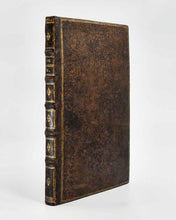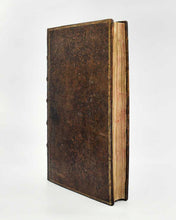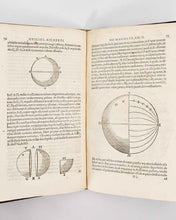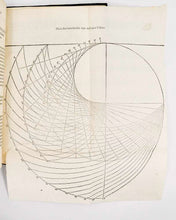
GILBERT, William. De magnete, magneticisque corporibus, et de magno magnete tellure; Physiologia noua, plurimis & argumentis, & experimentis demonstrata. London: Peter Short. 1600.
Small folio. Late 17th-century mottled calf, double fillet border to boards in gilt, spine gilt in compartments, lettered directly to one, others with central lozenge tool, edges sprinkled red; pp. [16], 240, woodcut printer’s device (McKerrow 119) to title, large woodcut arms of Gilbert to title verso, one woodcut folding plate, 88 woodcut illustrations and diagrams in text (4 full-page), woodcut initials, head-, and tailpieces; spine and extremities very skilfully repaired, hinges reinforced, very light wear to boards, a few tiny holes to front board; subtle repair to title (touching one letter), small paper flaw to R1, closed tear (repaired) and subtle repair to folding plate, a few minor spots, otherwise a very clean, crisp copy; early ownership signature in ink to title, occasional early ink annotations, underlining and corrections (see below).
First edition, beautifully preserved, of the foundational work in both magnetism and electricity, and “the first major English scientific treatise based on experimental methods of research” (PMM).
William Gilbert (c. 1544-1603) was a natural philosopher from Colchester, who served as royal physician to both Elizabeth I and James I. Gilbert’s scientific endeavours were primarily concerned with magnetism – he is the first to use the term “magnetic pole” – but his exploration of amber’s attractive effects led him to coin the terms “electricity”, “electric force”, and “electric attraction”. His versorium (a freely rotating needle, see illustration at p. 49) was the first instrument devised to study electrical phenomena, functioning as both electroscope and electrometer.
Divided into six books, De magnete combines historical review, theoretical innovation, and experimental demonstration. Book I surveys the history of magnetism and culminates in Gilbert’s central postulate: that Earth is itself a giant magnet. Books II-V explore magnetic actions such as coition (mutual attraction), orientation, variation, and declination. Gilbert distinguishes magnetic from electric phenomena, formally establishing electricity as a separate field. He introduces the category of “electrics” (substances like amber that attract light objects when rubbed) and provides detailed instructions for the construction and use of testing instruments. Gilbert’s experiments with the terrella (a spherical lodestone used to model Earth, see p. 192) enabled him to demonstrate and explain phenomena such as the compass needle’s orientation, the magnetic dip described earlier by Robert Norman, and variations caused by local irregularities in Earth’s magnetic field. His practical suggestions for improving navigation included constructing instruments and compiling charts of compass variation.
In Book VI, Gilbert turns to cosmology, arguing, drawing on medieval ideas from Peter Peregrinus’s Letter on the Magnet (1269), that the Earth’s diurnal rotation is a magnetic phenomenon. After Peregrinus, “De magnete provided the only fully developed theory … and the first comprehensive discussion of magnetism” (DSB). The book had a lasting impact, influencing figures such as “Kepler (112), Bacon (119), Boyle (141), Newton (161) and in particular Galileo (128), who used his theories to suggest his own proof of the findings of Copernicus in cosmology” (PMM). Throughout De magnete, Gilbert challenges older authorities, favouring firsthand observation and repeatable experiments. His systematic approach, framing new theories, testing them experimentally, and documenting procedures, prefigures the scientific method that would come to define seventeenth-century natural philosophy.
Provenance: The corrections on pages 11, 22, 63, 72 – which are also found in some other copies – are traditionally attributed to Gilbert’s own hand.
ESTC S121112; Dibner, Heralds 54; Grolier/Horblit 41.
#2122168













